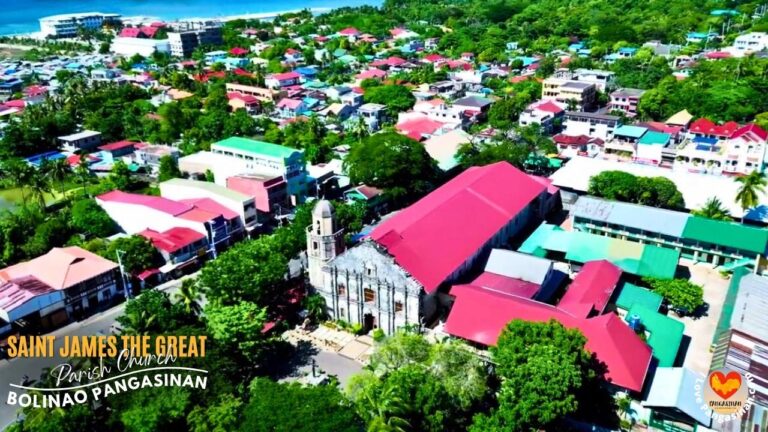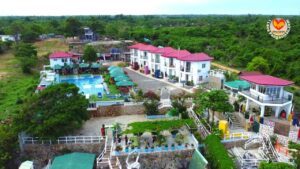
Saint James the Great Parish Church, also known as the Bolinao Church, is a Spanish colonial church located in Bolinao, Pangasinan, Philippines. It was built in 1609 by the Augustinians and is one of the oldest churches in the Philippines. The church is made of black coral stones and is known for its intricate architecture and beautiful interior.
The church is a popular tourist destination and is a must-visit for anyone visiting Bolinao. Visitors can admire the church’s architecture, learn about its history, and attend Mass. The church is also a popular spot for weddings and other special events.
It is a beautiful and historic church that is worth visiting if you are ever in the area.
Saint James the Great

The church is dedicated to Saint James the Great, one of the twelve apostles of Jesus Christ. He was known for his zeal and his preaching. He is also the patron saint of Spain, pilgrims, and soldiers.
Saint James is also known as the “Apostle of Spain,” and he is said to have appeared to King Ramiro I of León in 844, leading to the victory of the Christians over the Moors at the Battle of Clavijo. This victory was seen as a sign of God’s favor, and Saint James became even more popular in Spain.
When the Augustinians arrived in Bolinao, they would have seen the similarities between the people of Bolinao and the people of Spain. Both groups were primarily farmers and fishermen, and they both had a strong Catholic faith. The Augustinians would have also seen the challenges that the people of Bolinao faced, such as the threat of pirates and the harshness of the environment. They would have believed that Saint James, who was a powerful warrior and a protector of the Church, would be a powerful intercessor for the people of Bolinao.
The feast day of Saint James is celebrated on July 25, and it is a major event in Bolinao. People from all over the province come to Bolinao to celebrate the feast, and there are religious processions, traditional dances, and a variety of other activities.
Saint James the Great is still the patron saint of Bolinao Church, and he is still a popular figure in the town. People of Bolinao pray to him for protection and guidance, and they believe that he will help them to overcome the challenges that they face.
Check out this video for a closer look at Saint James the Great Parish Church.
HISTORY:

The first religious friars in Bolinao were the Augustinians who stayed in the town from 1585 to 1587. The Dominicans took charge from 1588 to 1599. In 1600, the Augustinians returned and stayed until 1607. The missionary work left by the Augustinians was taken over by the Augustinian Recollects who administered the town from 1609 to 1679, up to 1712 when the Dominicans took over again. When the Recollects returned in 1609, they transferred the town to the mainland because of the troubles inflicted by the piratical raids. The Recollect fathers returned in 1749 and took charge until 1784. Since then, several priests administered the parish.
Over the course of its 400-year history, St James the Great Parish Church has survived numerous catastrophes. The bell-tower “Campanario” of Bolinao Church measuring seventy-five (75) feet was then the tallest in the whole Pangasinan if not in the entire Northern Luzon. However, an earthquake in 1788 toppled about half of it.
In 1819, the two-storey Convento (convent) adjacent to the church went up in flames. And in 2009, the church’s roof and ceiling sustained heavy damage following the onslaught of Typhoon Emong.
The first priest was ordained in Bolinao Church in 1974. In 1985, it became a parish of the Diocese of Alaminos, previously under the Diocese of Lingayen.
ARCHITECTURAL FEATURES:
The Saint James the Great Parish Church is a beautiful example of Spanish colonial architecture. It is a three-aisled church with a bell tower. The façade of the church is decorated with Baroque-style ornamentation
Double doors attached to a trefoil archway serve as the church’s main entrance. Found at the very heart of the church’s facade, these imposing wooden doors are flanked on either side by columns, windows, and tall blind arches with niches. The 75-foot high Campanario, once the tallest bell tower in the province, is attached to the left side of the church and can be accessed from the second floor. The baptistry below the Campanario’s entrance holds the Retablo Minor, an ornate altarpiece that is said to have come from Mexico via the Manila-Acapulco Galleon Trade route.
The interior of St. James the Great Parish Church has three main focal points, chief of which is the Altar Mayor and its intricately carved retablo bedecked in gold. The other two, the Pulpito (pulpit) and Altares Minores (side altars), are noteworthy because most modern-day churches no longer feature them. The elevated Pulpito, still positioned in an acoustically strategic spot for maximum audibility, is an architectural relic from the time before microphones and other sound-enhancing technology became accessible. Meanwhile, the two Altares Minores were used in the past whenever Masses were co-celebrated by more than one priest.

The church underwent a series of natural and man-made calamities, such as the 1788 earthquake, the 1819 fire incident, and Typhoon Emong in 2009. And has since then been undergoing repairs and renovations.
Each of those times, and indeed all the other times the church was struck by calamities, St. James the Great Parish Church was able to rise anew. Its centuries-old retablos and carved images are well-maintained and in use to this day.
Despite this, the restored church combines its original elements with new improvements. Step-form buttresses and steel trusses were added to the original structure to provide added strength against earthquakes. In the 1880s, the roof’s old tejas gave way to galvanized iron (GI) sheets. The baldosas or floor tiles that were added to the interior in the same period have now been replaced by marble flooring.
A ceiling mural by Bolinao’s own Nestor Cañas is the latest addition to the church. Commissioned in September 2017 by Rev. Fr. Bayani “Yannix” Liguid, the mural covers the entire ceiling with scenes from the mysteries of the Most Holy Rosary. The artist, who also painted the church’s 14 Stations of the Cross in 1991 and the mural of St. James the Great at the entrance ceiling, single-handedly undertook this passion project for over a year. He completed it in October 2018, in time for the Cristo Rey celebration hosted by the parish.
SIGNIFICANCE
The Saint James the Great Parish Church is an important cultural and historical landmark in Bolinao. It is a reminder of the Spanish colonial period and the early history of the Philippines. The church is also a popular tourist destination and is a must-see for anyone visiting Bolinao.
Marker: The First Mass on Philippines was celebrated in Bolinao Bay in 1324


A plaque that identifies Bolinao as the site of a Mass that predates the one celebrated in Limasawa in 1521. As stated on the marker, a storm is said to have forced the Blessed Fr. Odorico to take momentary refuge in Bolinao in 1324. While there, he is said to have held a Mass of thanksgiving and also to have baptized several locals. The marker was donated in 2007 by Fr. Luigi Malmocco, a priest from Fr. Odorico’s hometown of Friuli.
However, historians, including William Henry Scott and our own National Historical Commission, have found no written reference to support the veracity of this supposed journey and Mass.
Further, the National Historical Institute recognized the historical records of Limasawa in Southern Leyte as the venue of the first Mass, held on March 31, 1521.
Featured in Legoland Malaysia Resort
The town center of the Saint James the Great Parish Church in Bolinao, Pangasinan was one of the Miniland models featured at the Legoland Malaysia Resort. It was the only Philippine town featured at the said park.


Things you can do when visiting Saint James the Great Parish Church:
- Admire the church’s architecture. The church is a beautiful example of Spanish colonial architecture. The walls are made of black coral stones and the interior is decorated with intricate carvings and paintings.
- Learn about the church’s history. The church has a long and rich history. It was built in 1609 and has been through a lot in its time. It has survived earthquakes, fires, and typhoons.
- Attend Mass. The church is a popular spot for Catholics to attend Mass. If you are visiting on a Sunday, be sure to check the schedule and attend a service.
- Take a tour. The church offers tours that will give you a closer look at the architecture and history of the church.
- Buying Souvenirs and Pasalubong. There are a variety of souvenir shops on the left side of the church selling a variety of religious items, including rosaries, crucifixes, and prayer cards. They are also selling handicrafts and local delicacies.
References:
- https://en.wikipedia.org/wiki/Saint_James_the_Great_Parish_Church_(Bolinao)
- https://philippinefaithandheritagetours.com/st-james-the-great-parish




















